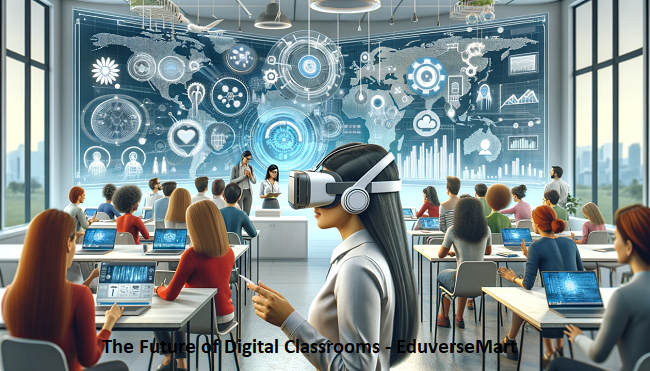The Future of Digital Classrooms In today’s rapidly evolving world, technology has become an integral part of our daily lives, reshaping the way we work, communicate, and learn. In the realm of education, digital advancements are revolutionizing traditional classroom environments, ushering in a new era of interactive and immersive learning experiences.
In the ever-evolving landscape of education, the digital revolution has emerged as a transformative force, reshaping traditional classroom dynamics and paving the way for innovative learning experiences. As we stand on the cusp of a new era in education, it becomes increasingly apparent that the future of classrooms lies in harnessing the power of technology to enhance teaching and learning outcomes.
From augmented reality (AR) and virtual reality (VR) learning to the integration of Internet of Things (IoT) devices and adaptive learning platforms, the potential for digital classrooms to revolutionize education is boundless. In this exploration of the future of digital classrooms, we delve into the key trends, technologies, and strategies that are shaping the educational landscape and paving the way for a more dynamic, inclusive, and effective approach to learning in the digital age.
In this blog post, we delve into the exciting realm of digital classrooms and explore how technology is reshaping the landscape of education. Join us as we uncover the potential of digital classrooms to enhance engagement, collaboration, and learning outcomes for students worldwide.
Transforming Traditional Education: The Rise of Digital Classrooms
In the era of rapid technological advancement, traditional education is undergoing a significant transformation with the emergence of digital classrooms. These innovative learning environments leverage technology to enhance teaching methods, engage students, and foster collaborative learning experiences, paving the way for a more interactive and effective educational journey.
Let’s discuss the latest innovations, trends, and advancements in educational technology that are revolutionizing traditional teaching and learning methods
Advancements in Educational Technology
The integration of technology into education has opened up a myriad of opportunities for both students and educators. Augmented Reality (AR) and Virtual Reality (VR) learning, for instance, offer immersive experiences that bring lessons to life and enhance understanding. By leveraging AR/VR technology, students can explore historical landmarks, dive into the depths of the ocean, or even journey through the human body—all from the comfort of their classroom.
Additionally, the adoption of Internet of Things (IoT) devices has revolutionized classroom management and student engagement. Smart boards, interactive displays, and IoT-enabled devices allow for dynamic and collaborative learning experiences, where students can actively participate in lessons and interact with digital content.
Access to Educational Resources and Supplies
The rise of online education supplies and educational marketplaces has transformed the way schools procure resources and supplies. Teachers now have access to a vast array of digital tools, e-books, and curriculums, enabling them to personalize learning experiences and cater to diverse student needs.
Furthermore, educational technology solutions providers play a crucial role in supporting schools and educators in their digital transition. From learning management systems to assessment tools and academic support services, these providers offer comprehensive solutions that streamline educational processes and enhance teaching effectiveness.
Classroom Infrastructure and Equipment
The modernization of classroom infrastructure and equipment is another key aspect of the digital revolution in education. From ergonomic furniture and flexible seating arrangements to state-of-the-art lab equipment and STEM-based kits, schools are investing in environments that foster creativity, collaboration, and innovation.
Moreover, advancements in robotics and AI technologies are paving the way for hands-on learning experiences in robotics clubs and coding workshops. Students are exposed to real-world challenges and develop critical thinking, problem-solving, and teamwork skills through project-based learning activities.
Teacher Training and Support Services
Empowering educators with the necessary skills and support is essential for the successful implementation of digital classrooms. Teacher training and development programs focus on enhancing pedagogical practices, integrating technology into lessons, and fostering inclusive and equitable learning environments.
Recruitment services play a vital role in attracting and retaining qualified educators who are passionate about leveraging technology to enhance teaching and learning. Academic support services provide ongoing guidance and assistance to educators, ensuring they have the tools and resources needed to succeed in a digital classroom setting.
Student Well-being and Support Services
In addition to academic excellence, student well-being, and support services are paramount in digital classrooms. Student counseling services offer mental health support and guidance, addressing the social and emotional needs of students in an increasingly digital world.
Educational excursion services provide opportunities for experiential learning outside the classroom, allowing students to explore diverse cultures, environments, and perspectives. Infrastructure development services focus on creating safe and inclusive learning environments that promote student well-being and academic success.
Special Education and Inclusive Learning
Digital classrooms have the potential to break down barriers and create inclusive learning environments for students of all abilities. Special education products, such as adaptive technologies and assistive devices, empower students with disabilities to access educational content and participate fully in classroom activities.
Ensuring inclusivity in digital classrooms requires specialized classroom supplies and accommodations tailored to the diverse needs of students. By leveraging educational technology and adaptive learning resources, educators can provide personalized support and accommodations that meet the unique needs of each student.
Conclusion
Undoubtedly, the educational landscape is rapidly shifting towards digitalization, marking a profound transformation in teaching and learning methodologies. Embracing this digital revolution allows educational institutions to craft vibrant and interactive learning settings, equipping students with the skills they need to excel in today’s digitally-driven society. Through the strategic utilization of cutting-edge educational technology, coupled with robust investments in infrastructure and teacher development programs, we can address disparities in education access and provide every student with the tools and resources they need to succeed in the modern world and beyond.

